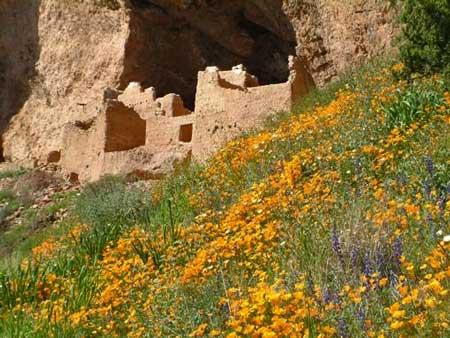One of the oldest national monuments in the country celebrates its anniversary today, and it's been around for over a century. The primary attraction in this Arizona park has been around a lot longer, and if you're up to a bit of a hike, you can take a walk through a house built 700 years ago.
Tonto National Monument was established by Presidential Proclamation on December 19, 1907—the eleventh site to be protected under the 1906 Antiquities Act. Back in those days, there was no National Park Service, so the area was initially managed by the U. S. Forest Service. It was transferred to NPS jurisdiction on August 10, 1933.
If you enjoy rugged desert scenery and fine examples of cliff dwellings, this park is well worth a visit. The site was established primarily to preserve cliff dwellings from the Salado Culture.
The well-preserved Lower and Upper cliff dwellings were occupied during the 13th, 14th, and early 15th centuries. The people farmed in the Salt River Valley and supplemented their diet by hunting and gathering native wildlife and plants. They were fine craftsmen, producing some of the most exquisite polychrome pottery and intricately woven textiles to be found in the Southwest. Many of these objects are on display in the Visitor Center museum.
Two separate trails provide access to the park's prime attractions.
The self-guided Lower Cliff Dwelling Trail covers one mile and climbs 350 vertical feet. The trail winds its way through the Sonoran desert and provides a beautiful view of Roosevelt Lake in the valley below. Once you arrive at the dwelling, you can walk through homes that were last occupied 700 years ago. Don't worry about tracking dirt on the carpet, but please don't climb on the walls or walk on the roof. The landlord will appreciate it if you stay on the path during your visit.
Guided tours are offered to the Upper Cliff Dwelling several days a week from November through the end of April and early bird tours are offered each Saturday in October and May at 8:00 a.m. to beat the heat. Reservations are required for all Upper Cliff Dwelling tours, which are limited to 15 people, and often fill quickly. Call (928) 467-2241 to make a reservation.
If you're an experienced hiker, here's a unique opportunity: A full-moon hike to the Upper Cliff Dwelling is scheduled at 5:30 p.m. on Monday, February 9, 2009. Reservations are a must for this trip.
The trail to the Upper Cliff Dwelling is a backcountry trail. The first half of the route meanders through a wash while gaining elevation, and requires negotiating shallow water and some climbing on large rocks. The second half of the trail winds steeply via switchbacks and requires climbing a total of about 60 unevenly spaced steps. Keep in mind that reaching the dwelling is only half of the hike; you must return via the same route.
The hike is 3 miles round trip, with an elevation gain of 600 feet. The tour takes 3 to 4 hours. The guide will keep a moderate pace and stop frequently to talk about natural and cultural history. Rarely, a tour may be canceled due to extreme weather conditions or possible flash flooding. If they can anticipate this, the park staff will try to call those who have reservations.
Although the cliff dwellings are the primary attraction, the park's 1120 acres also boast some great natural features.
At first glance, the tremendous differences in elevation impact the senses. It is an experience of sweeping vistas from the visitor center to the valley below and then beyond, to the mountains rising over 5,000 feet above the former river valley. Considered some of the most rugged terrain in the state of Arizona, slopes in the monument range from two to ninety percent. The monument rises high above the valley, now filled by Roosevelt Lake.
Fall through spring are the best months for a visit to this area, and if you're fortunate to be there in a year with good winter rains, wildflowers are a real bonus. In a good year, you might spot gold poppies, purple lupine, red Indian paintbrush, and white desert chicory. The bright pink blooms of the hedgehog cactus arrive in March and April, while Arizona’s state flower, the white saguaro blossom, opens in May and June.
Tonto National Monument is located 30 miles northwest of Globe, Arizona, on Highway 188. Driving time from Phoenix, Scottsdale or Mesa is approximately 2 to 2 1/2 hours; from Tucson or Flagstaff, 3 to 3 1/2 hours. Driving directions are available on the park website, along with important information about road construction which will be underway through mid-April, 2009.




Add comment